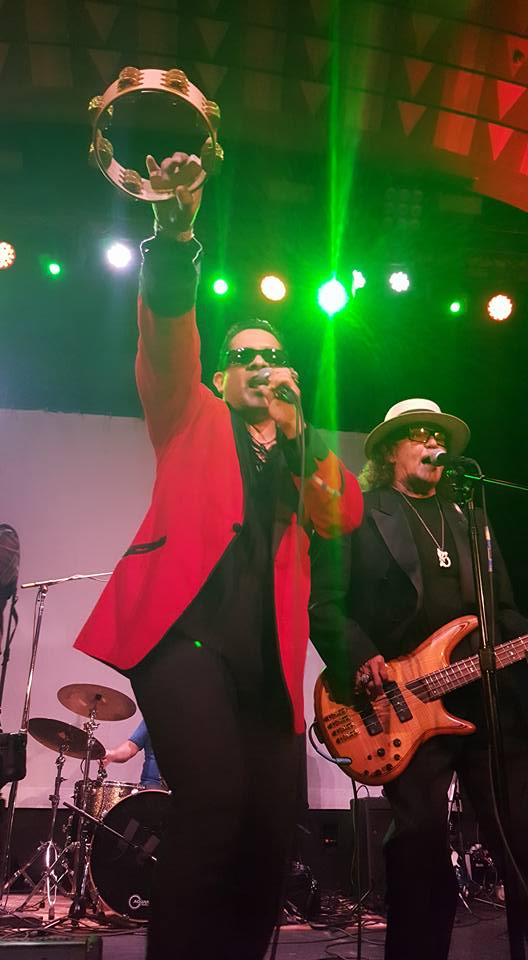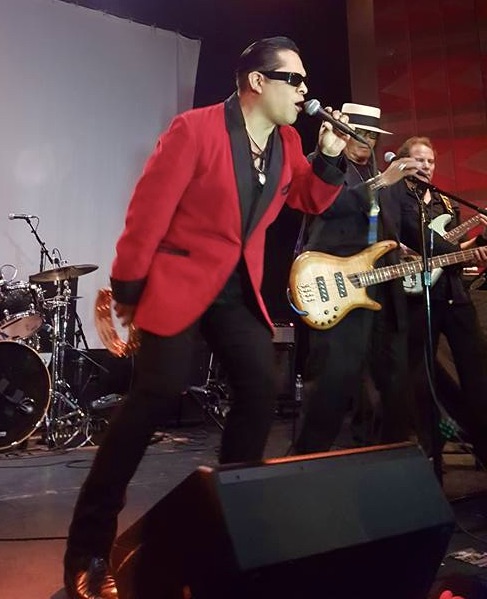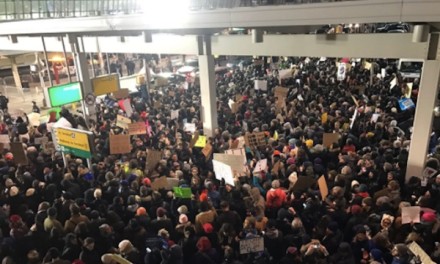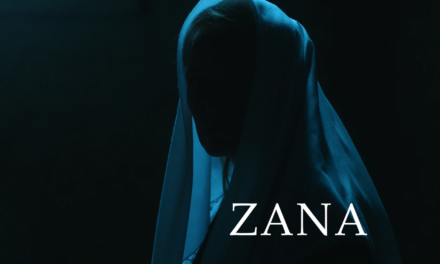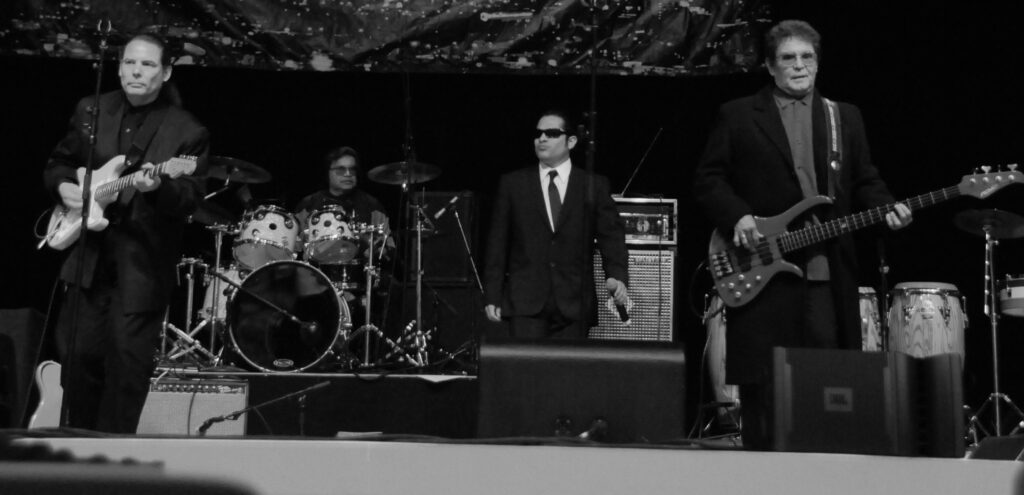
By Lani Cupchoy, Ph.D.

Lani Cupchoy is a Public Historian-Artivist-Photographer-Filmmaker whose research focuses on
Chicanx-Latinx Studies, Ethnic and Gender Studies, U.S. Transnational/Global History,
Indigenous knowledge, Critical Food Studies, Oral History, Digital Storytelling, and Critical
Civic Engagement. She is also an award-winning filmmaker of Truth Seekers, Urban Seeds,
Food Medicine, and Aloha Soul Food, documentaries that illuminate the power of community
engagement and social justice. A former elected school board member for Montebello Unified,
Lani led important grassroots policy-making initiatives including the K-12 ethnic studies
requirement and the expansion of district-wide school-based gardens. She currently serves as
Assistant Professor of Chicana(o) Latina(o) Studies at California State University at Los
Angeles.
For Landscape Latino
I sat down with Gregory Esparza, lead vocalist of two legendary Chicano bands, Cannibal and the Headhunters and Thee Midniters, to discuss his musical journey and experiences in the industry as well as a historical exploration of consciousness development for the Chicana/o/x community.
Lani: Welcome Gregory Esparza, let’s start with your personal story. Please introduce yourself.
Gregory: When I hear the question, I perceive it as, “Who are you?” and right away my mind races philosophically thinking all these things that I am and not sure where to start. But I also drift back to when I was at El Cerrito elementary school in La Habra when I first became curious about who and what I was. As a young kid, I didn’t know it at the time, but media shaped my thoughts and awareness about the world we lived in. Through television, society taught me what was good or bad, attractive, or not. Still, I was your general kid in the 1970s running around everywhere, talking too much in class, not understanding the importance of homework, and living for recess. I boiled down to an average student barely hanging on academic-wise, since for me school was purely a social experience. I loved spending time with friends, playing, and making new ones.
But I also noticed other things right away about myself, a deep little thinker, right from kindergarten. I was very shy but had romantic notions about love and marriage. I liked all the girls but also noticed how they liked all the white boys. So, I’d look in the mirror and look at my face and my brown eyes and wider nose and think this is me. It’s something I did through the years as I got older as if staring back into my consciousness. However, as it happened one recess in the second grade when we picked the kickball teams, as always, it’d be the Mexicans against the Americans, practically re-enacting the Alamo, since war movies were big when I was a child and we all watched them. I played on the American team because we all spoke English and there were all these Mexican kids that only spoke Spanish. I looked like them, but I didn’t speak Spanish, and for some reason when Mom picked me up that day, I asked her what we were. She talked about how we were Americans but with Mexican roots and I let out a deep breath and thought, “Ooooh.” This new fact sank in as I mentally journeyed scenarios about where and how I fit or did not fit into the world I loved. I thought this was why the girls liked my friends more and about how I didn’t look like all my heroes from tv and film, or like my favorite athletes, and music heroes, who were all either black or white. So, I grew a sense about myself and found it hard to discover where the “coolness” of our people was. Since even as a kid “cool” factors reigned, and we all knew what was cool or not, and being Mexican was not cool in the 1970s.
These infiltrated perceptions and false narratives about our people happened to us after decades of Americanization shamed the spirit of our Mexicanness taught in schools since the 1930s. So, I lacked confidence in myself. I didn’t see us anywhere in popular media but noticed that we looked more like the American Indians getting shot by the cowboys who I always mistakenly rooted for. Looking back at the second grade, these were my “Neo/Matrix” moments of awakening as I moved forward thinking about my place in the world. White people were framed as the “real” Americans while we were seen as a threat and not American. As I got older it became tough to wonder how I could sing in front of an audience of people that looked like me, but I couldn’t speak Spanish, while the popular world remained black and white. But Thee Midniters ended up helping me see another possibility. If only I could build a time machine and go back in time.
I wondered about when my Pops went to Garfield High School in the late 1950s and early 1960s, compared to my mom’s early 1960s La Habra High School yearbooks, when there were even fewer Mexican Americans at the school when she graduated in 1962. In Pop’s yearbook, a Mexican American world dominated within those black and white photos of classic, clean-cut, sharp-dressed Mexican American kids, looking cool and numerous. I didn’t see any white kids in the photos. Unlike La Habra where mostly white kids attended. The old black and white photos made me wonder what happened to everyone. But I knew enough that East L.A. compared to La Habra in North Orange County, were places just far enough away from each other, and that the politics happening within the Mexican American/Chicana/o-polis of East L.A. didn’t reach La Habra so much. Life was different in my hometown where I never knew anyone that called themselves Chicanas or Chicanos. If anything, many people said they were Spanish.
As for me, I was now Mexican American and Chicano to my cousins in East L.A. Added to that, I had my Mexican American and “Spanish” friends who didn’t speak Spanish so well and I also made friends with Mexican kids too. Strangest of all, language stopped me from ever playing Thee Midniters album my Pops had because I saw the guys on the cover and thought it was a Spanish-sung album. But one day, a broken heart changed all of that when I needed to hear something different to cure my sadness. To my surprise, I was shocked when they started singing and I heard the words, “I know I know I need someone…” It was like hearing Sinatra with a bit of soul. They were cool, and, like the cool black and white photos I grew to love in my Pop’s yearbook, Thee Midniters gave those photos a soundtrack and allowed me to imagine how we sang beautiful ballads and rocked out as Chicanas/os/xs on center stage too.
So, who am I? I was born to my parents, Rosalie and Theodore Esparza in L.A. County on July 14, 1969. I have an older brother Christopher by 11 months and a few years later my sister Monica and brother Erik were born. We were raised in my mom’s hometown of La Habra in North Orange County but also spent lots of our childhood in East L.A. playing with all the cousins. The reason for going to East LA so much is that my mom was an only child in La Habra, while my father, born and raised in East L.A. had nine brothers and five sisters. Right from the start memories of holidays, birthdays, and other family gatherings endlessly happened, as we spent our time out there. Wrestling, running, playing ball in the streets, climbing on, and crawling under houses and sheds, playing with bugs, and getting sweaty in the night air is what we did. Once back indoors, steam emanated from the tops of our heads, as the aunts and uncles, and other adults danced to the music late into the night. The music only stopped playing when a burst of screams and fast violence ended the festivities, and we’d climb back into the family van headed home. Sometimes with a few stowaway cousins in tow for an unexpected sleepover as we’d shoosh each other to me for a successful getaway.
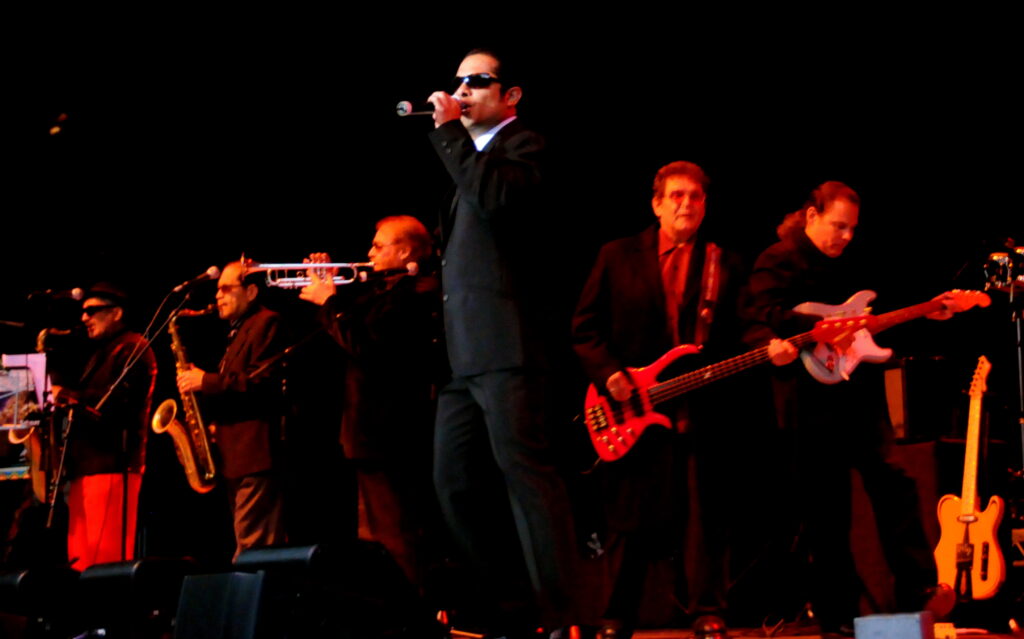
Lani: Wow, such a fascinating personal story and it seems like music has always been an important factor in your life. How did you get started with music and how has the journey been so far?
Gregory: I grew up on Elvis’s movies in the 1970s that came on regularly and I’d stand in front of the tv singing and dancing. But most importantly, Pops planted that seed in me as he always encouraged me. He’d say, “You can do that” over and over. In the house, he’d play the guitar and sang a world of songs to us that touched upon all the emotions of humanity from new love to heartaches and in time, I began to sing along with him. I can’t recall my exact age, but I was younger than ten years old for sure when Pops sang, and Mom used a portable cassette player with a microphone to record us singing and she’d interview us. I remember one time, we sang “John Jacob Jingleheimer Schmidt” a children’s folk tune that eventually gets to a whisper. It’s how we learned it in school and the day I sang it at home when I got to the whispering part you could barely hear me, and everyone yelled for me to stop wasting the tape, to which I said, “But that’s the way the song goes.” As I got into my teens, I experimented with all my favorite singers and emulated their emotional sounds and drawn-out vocal phrasings. I’d hold long notes and sing along to everyone in my parent’s record collection, from Johnny Mathis to Sinatra, Nat King Cole, The Four Tops, Chilites, Stylistics, Bloodstone, The Delfonics, everyone. I felt I matched their passion very well but was never sure if I was hearing myself correctly. I needed others to validate me once I got the courage to sing outside of the house and that process went on for years.
By the time I got my driver’s license, I’d drive my Pops into East L.A. to spend time with his brothers for drinks and singing all night long. Sometimes, after piling into the van to go to a family gathering, my mom would say, “Remember you promised not to drink tonight.” And within split seconds, plans were canceled, and we’d pile out of the van. However, one day I said, “Mom, I can drive him and make sure he stays okay” and she let me. That was the beginning of my school for singing, and I’d join them in all-night crooning sessions and howling at the moon with words of love and loss. Searching for my voice, my uncles provided affirmation, when they’d say things like, “That was just as good as the original.” Or, by my early twenties when I’d be at a bar on the Eastside, and in conversation with people older than me, they’d ask what I was doing there. In these years, the oldies scene is not the Chicanx soul scene happening today. Instead of hanging out with friends my age all the time, I spent half of it on the Eastside in darkly lit skinny bars where the oldies played, and sometimes, I’d sing acapella to the generation before me, of which people said things like “I haven’t heard that song sung like that since the original.” Which typically found me covering Midniter tunes like “To Be With You” “I Need Someone” and “That’s All.” But I sang lots of other songs too. After singing, sometimes people asked me to sign a napkin and comment how I was going to be somebody someday, as a bartender might slide over a drink on the house. I looked for these continued affirmations all along the way, to keep sensing if I was on course, on the right path.
Affirmations of which the legendary band Tierra also played a significant role in my life, when on several occasions, they allowed me into their music world. Their original bassist, Steve Falomir, had a side band performing at the Rim Ram in Norwalk, California when on their break he asked me what I did. I dressed the part before I ever was ever the part and told him I was a singer. So, he invited me up to sing a song. It was incredible and revealing all in one since I never sang in front of an electrified band before, and my mouth got dry from nervousness when I tried to sing as Falomir kept motioning for me to get closer to the mic. Conjuring as much saliva as I could during that short bridge in Thee Midniter’s, “I Need Someone,” I managed to salvage the moment on a high note but went back to the drawing board for months. I didn’t sound vocally close to anything I did in my room, as I did in front of the mic that night. These were lessons and growing pains. Then there was another time when Rudy Salas saw me standing and watching his band file through the backstage door of The Hop in La Puente when he stared at me for a few seconds and said, “You want to come in?” I was dressed sharp, and typical to my standard suit, trench coat, tie, and London Fog hat. Maybe he thought I looked cool, or maybe he recognized that spirit within me that looked familiar. Doomed and blessed to be called toward music all in one, while also trying to figure out how to get into the club for free, because money was always tight. It was my first time backstage anywhere. One other time, Tierra’s dynamic lead vocalist Mike Jimenez also called me, to my shock. He was so good I almost quit thinking of singing when I first heard him. This is a much longer story, however, but at the root of Mike calling me, it all spelled out the path I was on and most importantly, affirmation, signs on the road leading me to music.
Tierra was even there when I got my first girlfriend moment. I was eleven years old, 1980, at Roller Madness, a skating rink in La Habra, I asked this girl if she will ask Maria if she’d go around with me. It’s how you asked someone to be your boyfriend or girlfriend back then, and she skated back and told me Maria said yes! And just then, “Together” by Tierra started playing and we skated together, where she skated backward, and I held on in our skating slow dance.
Beyond affirmations, I need to go back to that moment when I discovered Thee Midniters in my pop’s record collection. From that moment at 16 years of age until I joined The Headhunters in 1998, Thee Midniters remained prominent in my dreams about singing. I studied their ballad-heavy catalog and eventually got into their rock tunes as well. All the while, I continued wishing about how I could have been young in the time of my father and wished that I went to school in East L.A. After a few years of immersing myself in their songs, I began to feel this inner knowing that somehow, I would become their singer one day if only they could ever hear me singing their songs. I was 19 years old, when one night with my cousins having some beers and listening to the oldies, I said out loud and into the night, “Wouldn’t it be something to sing their songs, with Thee Midniters, in a Valentine’s concert.”
Stranger is that I had these feelings and thought about joining the band before I even knew they were still actively performing. In fact, my first conceptions of Thee Midniters, along with all the black and white photos made it feel as if they were from a time out of reach, even though I could be standing right next to my parents, I couldn’t imagine Thee Midniters being around anymore. Hence, my dreams about having a time machine to go back in time to meet them and sing with them. It was not until the mid-1990s, that I discovered they were still around, from their name on the marquee at The Hop. When I ordered my drink and inquired with the bartender, he said, yeah and said, “There’s Jimmy Espinoza right over there on the steps.” I got my drink and walked right on over to introduce myself and said, “I know all your songs and I hope you can hear me sing someday.” He invited me back to the Hop the next day as a guest to see them perform. There is more story here about meeting them backstage. The second time backstage at The Hop once again, as Jimmy introduced me to the band, they didn’t hear me sing. This was also the night I first saw Tierra performing with Mike Jimenez sharing leads with Steve Salas. I practically fell out of my seat. This guy was phenomenal.
As the years stretched on a lot of dreaming, visualizing, and adventures happened in my wild 20s as I’d go around singing in unsanctioned spontaneous moments on the boulevard, in the alleys, and backyards to anyone captivated in thought or having their burger and fries when I’d drop a tune on ‘em. If they liked it, I’d sing a few more. My journey in music happened nontraditionally, self-taught, untrained, and experimental in my practice as I stumbled across this veil of happiness and safety that came with a song that could stop bullets from flying. Because everybody good homeboy stops for a great oldie, and I sang into that reality.
From here I will jump to when I got the opportunity to meet and audition for Cannibal and The Headhunters in late 1998. At the time, just before that chance came, one of Thee Midniters’ first vocalists, Lil Ray Jimenez, had heard about me singing and asked if we could meet at his studio, Sanctuary, to hear me sing. He offered the possibility of joining his family band and was kind and generous. Naturally, my nerves raced. I had never been in a real studio before, and this was the legendary Lil Ray. Literally, the most soulful, Little Richard-type voice that came out of the Eastside in the 1960s. In all fact, he should have been a household name like all the other popular soul singers of his era and at one point Motown courted the idea of signing him, but it fell through. I don’t recall all the details but think this happened during the time when they moved from Detroit to L.A. and the business model was in flux for Motown. Although I never joined his band, what is significant about that meeting was the moment he reached for a book and said, “Hey look, my pictures in it” as he held up Land of 1000 Dances by Reyes and Waldman. This was 1998 and as we know, by this time I knew Thee Midniters were still performing, which is a whole other story, but now here was this book filling in so much backstory about all the bands from the Eastside that I went out and found a copy and read it front to back in a matter of two days. It sparked my desire to find a band to join and in the spirit of serendipity that coming weekend an entire day of “battle of the bands” was set to happen at the ‘Ol Montebello Inn. Another one of those dark skinny little Eastside bars. I planned to be there early to see all the bands and try to figure out if maybe I could fit in with anyone. But as it happened, other habits intervened when typical, in my twenties, I did an all-nighter up in Hollywood and at the after-hours rave scene and I slept in. Looking at the clock, I missed the day, still blurry and tired, I thought maybe I can manage to get there for the last 45 minutes. However, when I got there, everyone was breaking down their gear and exiting as I walked in to get a drink. During these years I knew of a famed local bassist and keyboardist, Joe “Baby Brother” Garibay. He played and sang with a lot of soul. Everyone called him Baby Brother because he was older, overweight, and bald, except for that twist of hair at the top of his forehead. The kind of hair you might see on a newborn, hence the name. So, I walked in, and Baby Brother says to me, “Hey (smiling) you know Cannibal and the Headhunters is looking for a singer and I think you’re the guy.” At the time he played keys and bass under the band direction of Andy “The Hitman” Tesso, the Rampart Records session guitarist for all the bands in the 1960s. Baby Brother gave me instructions, that a month from then the Headhunters were going to be at the House of Blues on the Sunset Strip, and that I should be there to meet them, and I did.
There are a lot of stories to tell at this moment that blends with my time having already met Thee Midniters for the first time, sometime between 1992 and 1995. And now for a second time in 1998 since they were on the bill with the Headhunters that night at the House of Blues. When I got there The Headhunters were on stage. Their sound was deep and legitimate soul as I took my Gray London Fog off and placed it over my heart in allegiance to the original soul before me. Before their show ended, I made my way down to the stage to let Baby Brother know I made it. Hearing them sing I realized I never heard original soul live before. The only thing that came close to it were those barber shop-type singers you’d catch at Disneyland or Knotts Berry Farm between eating your funnel cake and gulping down a cool soda. After the show, Baby Brother walked me over and introduced me to Bobby “Rabbit” Jaramillo and Richard “Scar” Lopez, the original singers from the 60s. Rabbit said, “Well do you think you can do that?” I said “Yes” without pause, even though I had never harmonized in my lifetime. I only sang along to the leads on the records, but a few nights after meeting them I auditioned. I sang a few Midniter songs and after a few days past they offered me the spot to cover Cannibal’s parts. Cannibal had sadly passed away from AIDS in 1996, and when the group was recognized for a lifetime achievement award, they figured on getting back their four-part harmony for the shows. At the time, Joe “YoYo” Jaramillo was terminally ill, and so Charlie Muñoz from The Ambertones covered that third harmony. By joining them, I learned by ear, the skill of soulin’. Rabbit would say, “You’re flat.” Sometimes I’d be sharp and sometimes right on as they described a deep “Ewww” sound to be breathier, like a “Woooo” like a deep choo-choo train or how a baritone line was like talking as the other three voices acrobatically danced around it. Instead of falsetto, tenor, second tenor, and baritone, they’d call the voices top, second, third, and bottom. Charlie told me in time I would be able to harmonize to any song on the radio and in time it happened. My time with the Headhunters is exceptional in time that consisted mostly of rehearsals with few shows from 1998-2005, because of contention between another person that grabbed ownership of the group’s name in 1999. Which is something Rabbit and Scar didn’t want to bother me about, but they let me know what was happening when I called them one night asking about a marquee with the group’s name slated for a show the next night. That’s how I learned more about the music scene, where people outside of the group were vicious for ownership and I witnessed and experienced nasty verbal encounters, with both legal and physical threats over music activities that never amounted to big money. No millionaires in that game, but I stuck with the group because they gave me my first shot and I loved being a part of getting them back to the stage to re-live moments about their fast rise to fame in the mid-1960s with their one-hit wonder “Land of 1000 Dances” and touring with The Beatles in 1965.
Despite not doing many shows with the Headhunters, my time with them remains seminal. I miss them and wish that the lone surviving member, Rabbit, lived here so I could spend time with him and sing with him to lift his spirits. At 75 years of age, he is not in the best of health and although we talk occasionally, it is not like being in the same space to share the energy of music and a good song together. Recently, he was able to get online to drop into my Livestream as I sang songs and made spontaneous choices to show him some old Headhunters love and homage, while letting everyone tuning in know about the legend virtually amongst us that day.
By 2005, with Rabbit in Colorado and Scar not doing well, we did our last show at the 21st Annual Twilight Dance Series on the Santa Monica Pier. Getting to the stage was overly dramatic, as the current owner of their original record label, Rampart Records, along with the other band’s claim to the group’s name, both parties for different reasons threatened to sue the promoters of the show if we performed. However, we managed the situation and saved the show, but I feel these challenges ultimately provided reasons for Scar to call it quits. I don’t blame him. We stayed in touch, and eventually, I visited him in hospice until he passed away in 2010 from lung cancer. It was much harder on Scar after Rabbit left for Colorado and I didn’t want to do the show unless one of them were onstage with us. Someday I will do tributes to them, but at that moment it was about being with the original Cannibal and The Headhunters, only if they wanted to continue singing. By 2005, I had already met Thee Midniters for a third time in ‘03 as a direct result of my time singing with Cannibal and the Headhunters that made it happen.
I joined Thee Midniters the following year in 2006, and it was my dream come true. In all, my musical journey remains to a great extent non-traditional, but through the years I recognize where I’ve learned much from being in the room and getting familiar with stages, studios, soundchecks, and performances. I continue to learn about my voice with every show I do. I have done hundreds by now and singing with Thee Midniters, we’ve billed alongside numerous classic acts that I grew up listening and dancing to at all our Esparza family parties. With Thee Midniters, I’ve done everything from private shows to lounges, mid-size venues, casinos, and arenas, to sold-out crowds, and have experienced standing ovations. One time I walked into a casino dining room after a show and everyone stopped and stood up, giving me a standing ovation. Another specific time, I mean you know when you hit a grand slam and we had an impeccable show at Gallo Center for the Arts in Modesto, California, on the evening of February 20, 2016, the people rose from their seats and cheered. You don’t forget those moments and the energy shared. These moments are hard to explain, and I can only think that the memories and feelings that the songs and music hold are undeniable and speak to us in ways that are hard to describe. Yet there is familiarity in it all. Our community and culture break through, such as the time I met Poncho Sanchez, the great conguero, at a Moose Lodge in Santa Monica. We took a photo together and before he left, he complimented my show and said to me, “I know how you grew up.” You never forget these things.
In town, the most notable venue I performed at was The Greek Theater twice. First with Thee Midniters and a second time as a guest vocalist with Tierra, performing with Rudy and Steve Salas to my left and right. These are the moments where childhood dreams and reality blur into something surreal and unimaginable, but there you are, and it happens. Like the countless times, you sang “Together” with familia and friends late into the night after too many drinks, except now, there you are with the real deal in front of a few thousand jamming out the ‘ol song, if only Maria could see me now. You fly in the moment and dance across the bridges and frequencies. One time after a show, Frankie Firme, “The Al Capone of the Microphone,” ex-marine and Vietnam veteran told me how I touched hearts after singing “That’s All” and “Town I Live In.” Another time, after a performance at the Santa Fe Springs swapmeet, I was told about how they saw 6-foot cholos crying.
I’ve been in concert with Malo, War, El Chicano, Ersi Arvizu (The Sisters), The Intruders, Gene Chandler (The Duke of Earl), The Manhattans, Brenton Wood, Eddie Holman, The Floaters, Peaches and Herb, Lalo Guerrero, Mark Guerrero (Mark and The Escorts), The Eastside Allstars, Joe Bataan, Lysa Flores, Geree Gonzales (The Village Callers/Poverty Train), Cui Cui (Cuicani), Lighter Shade of Brown, Lisa Lisa, Kid Frost, Mellow Man Ace, The Sonics, The Trashmen, LaLa Brooks of The Crystals, The Crystal Antlers, Kid Congo Powers, Chan Romero, Dick Dale and The Destroyers, Tito Puente Jr., The Premiers, The Blendells, Thee Monclairs, Thee In Crowd, DW3, Rocky Padilla, Soto, The Sunliners, Rudy T of the Reno-Bops, The Blue Satins, Barbara Lynn, Duane Eddy, Sugar Pie DeSanto, and many others. But I would say, watching The Manhattans on night at Rabobank Arena in Bakersfield, it was an exceptional lineup of acts, and they just stole the show. Their precision, choreography, harmonies, and all made me feel like I was in a movie. Like the Five Heartbeats, a fictitious Motown-type band, but The Manhattans were flawless that night and it was a gem of a moment to watch them.
Lani: Thank you for elaborating on the different influences and connections you have made throughout your musical journey. Has music been an easy path overall and if not, what were some of the challenges you’ve had to overcome?
Gregory: So, in terms of my path being easy. The answer is no. Music life is a tough road, but I have no regrets. The funny thing is many people have told me how lucky I am. Some people even call me a legend. Which is something I always keep in perspective. I honor my position and always do what I feel a moment calls for to represent and do well for the legacy of the music. From a positionality perspective, I didn’t come from a band family, meaning not from a family with a legacy to build from. I saw how that worked for many others whose fathers modeled how to navigate this world. Instead, I came from a family of music lovers, drinkers, brawlers, and hard workers, and we sang, but no one could lead me beyond those spirits. The rest was up to me. Once I got going, I traveled this world nontraditional and mostly from that place where dreams come from. I imagined myself into it. The old records, songs, black and white photos, and finally those books from the 1990s altogether became my time machine and it was as if all that dreaming through the 1980s and 1990s found the past and the present all unfolded into moments that I began participating within every rehearsal and conversation I had and with every stage I took alongside those musical figures I admired since as a kid.
In terms of language. I felt from our community, that sometimes they expected that we all just knew Spanish songs too. I have performed in Spanish, singing, and in theater, with Spanish dialog, but it can become disabling when as Chicanas/os/xs, we come into an Anglo-dominated world of entertainment that expects us to all be a certain kind of ‘Mexican.’ When the reality is, speaking, writing, and creative productions happens first in the English language for me. Sadly, Spanish was taken from me long before I came into the world, but I still work on that skill to this day. They have never understood us as an English-speaking community from a standard business and communicative way. I have always found that odd. As an actor, in auditions, I’d get my lines and I’d run them through making mental commitments to them, all the while speaking the lines in my voice with my emotional choices. In action, I’d nail the lines, but then the director would say something like, “Now can you do it again but with a Spanish accent.” However, with music, I noticed how the industry celebrated our culture within Ethnic categories as well, as if they understood us better when we enacted or expressed our culture in music, but the moment we wrote, created, recorded, and performed in English, there are crickets. Once more, we should never negate the fact that there are successful stories that come from our Mexican American and Chicana/o/x communities. But that at large, I find our representation scant, overlooked, and regionalized, rather than widely reaching across the nation so easily, even in the digital world we live in now. I never dealt with big record labels, but everyone I know that did, has experienced trouble with the labels meddling with their identities, and this practice goes back to the beginning with accounts shared by the “Father of Chicano Music” himself, Lalo Guerrero. Of course, he went on to write and record epic songs mixed with Spanish and the hep slang Caló of his days, the fact is, Latinx, still contend with how they are represented and at times we see stage names still taken in place of familial surnames. I believe in many ways we are still dealing with a racialized music industry and have observed, once more since Lalo Guerrero, that through the decades many Mexican American/Chicanas/os/xs have chosen to go the independent record label route. Often that was their only choice, with some going so far as to launch their own labels to get their music out in the world.
From socioeconomic perspective there are also other parts about the music life, not often discussed. Where there are trade-offs along with the sacrifices. Outright, in our economic and material world, no one is doing themselves any favors if they expect to be living in the lap of luxury and comforts with a life in music. Most artists struggle and live for the gig, from one show to the next and while this is nothing new, it is a tough road of economic instability. There’s no health insurance, and the social challenges come from protecting your reputation while fending off stereotypes that people can come to believe about singers and musicians from movies and television. Relationships are tested and love is challenged. The love for your partner versus that musical calling also factors in. Expectations about your role as a man creep in, but some of us stay the course. We find partnerships that understand our creative calling and although the arts are not meant to be a perfect science, it all works, like the sounds from an orchestra at first warming up to finally getting to a harmonic starting point. As beautiful as music is, the life is not for the faint of heart. And it is a life full of adventures where the energy of it can find you on a plane traveling the world and seeing places, you never imagined you’d see as a kid. Many times, after a show, I’d take photos and sign albums, posters, t-shirts, and things, when often someone would tell me how lucky I was, but at the same time, I’d think about how lucky they were. I know their paths meant a job in the mundane. But I respected them just as much, to do that type of work, day in and day out, but that their labor came with a certain stability and they could settle down, get married, and raise a family. Not that artists don’t get married and have families, but for me, these were insurmountable, as I sorted out my place in music through the years.
Because of singing, I toured with The Poncho Kingz of Mexico City across France and on the island of Corsica, the towns of Bastia and Ajaccio. In Bastia, I slept in a hotel where the one next door was blown up by the local terrorists because they didn’t like French government buildings installed after WWII. They preferred to be Corsicans. Then two years later I got on a plane to Asia, singing across the Pacific on tiny islands, like Kwajalein and Roi-Namur, plus, Guam and Okinawa, and singing across Japan and South Korea. All that happened before ever hopping on a plane to New York. So, when I returned, I finally went to visit New York. That is how music works when you ride those musical frequencies and sonic waves.
Lani: Let’s go a little bit deeper with your experiences. Can you talk more about your journey with Thee Midniters as well as with Cannibal and the Headhunters?
Gregory: I always wanted to be a Midniter but I became a Headhunter first. The wild thing is how time works while in dream mode. You age differently, as opposed to traditional stages of life one mentally checks off from parenthood to becoming grandparents and retirement, the artist never truly retires. Their minds drift in inventive forms as mine did for nearly twenty years before joining Thee Midniters. And while The Headhunters gave me my first shot, Thee Midniters placed me right into the Latin Legends universe.
Still, The Headhunters gave me my first big break and my story with them is that we rehearsed two to three times weekly but did very few shows. As a result of contentions to do with someone that registered the band name under strange circumstances, the other challenges came from disagreements with their old record label’s new management. Strangest of all was that no one made big money from the shows we did, while it seemed that from the few opportunities that came for us to do, people fought for what looked like the prestige and reputation of the group more than anything else. All I could see were many missed opportunities if only these oppositional parties could dream, visualize, and collaborate more. Still, I also understood the personal value of the original singers and their passion for life, having fun, and basically wanting to relive moments onstage.
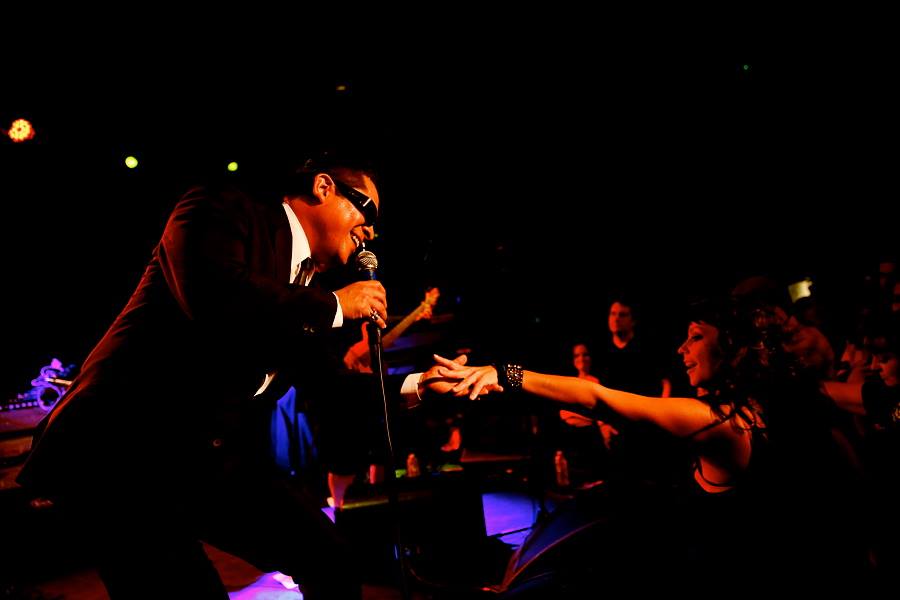
In 2000, at a hotel in San Pedro, California, we did the last official “Rowboat” together. A slick dance move, The Showcases, a black soul group from their neighborhood taught them, while they lived in Ramona Gardens Housing projects. The guys said that whenever they pulled it off it never failed to bring the house down. One by one, we’d plop to the ground and straddled each other as we pumped our arms like the rotation of the wheels on a train and propelled ourselves forward with our legs sliding across the stage on our butts. People screamed and laughed and had a great time watching us. Memories like that find their place in keeping their legacy alive in small ways. In the past couple of weeks, two seminal figures from the 1960s have passed away. Billy Cardenas of Rampart Records a prominent music producer and road manager for the Headhunters and the drummer and co-founder of The Premiers, John Perez, have passed away. This makes me want to go visit Rabbit.
My time with The Headhunters helped me answer many questions about myself and that I could do this thing called singing and dancing. If there was ever a song that people requested of me when we performed, it was “Gloria” made popular by the exceptional showmen from the group called The Cadillacs. A sweet song with fully vocalized phrasings, a talking part, and heartfelt falsettos that spoke from a guy in love with a girl named Gloria and no one else. Because of that song, and an invitation to sing it at a private party in my hometown of La Habra in 2003, Thee Midniters were there and heard me sing for the first time. The funny part is that I tried to get them to hear me sing when I met them sometime between 1992 and 1995 for the first time, and then for a second time in 1998, when I went to meet The Headhunters about auditioning for them. However, on this night in 2003, shortly after singing, someone walked over to me and said, “Hi, I’m Jimmy Espinoza from Thee Midniters and I think you could sing our songs.” Unbelievable as I thought how amazing, he didn’t remember me from the first two times I introduced myself, but now here he was talking about the tones of my voice and their catalog. It was an incredible moment. A few days later we had a meeting that lasted for hours, at a restaurant right next door to the house on Euclid where I grew up in La Habra. We talked for hours about the group’s history and all the critiques I had about the singers that followed in Willie G’s footsteps through the decades. Most importantly, when I left that meeting, I was third on the shortlist to be called to sing for them, and more years would pass before that call came unexpectedly one night in January 2006. I wondered if the call intentionally came after midnight when my silver Razr cellphone lit up and I flipped it open to answer. Jimmy’s voice came across and he asked if I could do a show with them in the next 30 days. It happened to be the big Valentine’s Super Love Jam at the HP Pavillion in San Jose, California. My dream came full circle as it was their classic ballads I sang with them, Thee Midniters, in a Valentine’s concert, but also to a sold-out arena of over 14,000 people in attendance. Wild. I went on to be their lead singer full-time until June 2021 when I decided to step away. We remain in contact, and I just recently reunited with them this past June 2022 in a Latin Legends concert at Save Mart Center in Fresno, California. I sang to a sold-out crowd of over 6,000 in attendance, followed by a ballroom performance in Northridge the next night. It happened to be Father’s Day weekend and fitting that we just laid my father to rest, where I did one of the hardest things in my life with his eulogy that I almost couldn’t finish. But I made it through it all and a couple of days later I celebrated him all Father’s Day weekend. Mentioning that he was the reason I found the love and courage to sing in the first place while celebrating all fathers no longer with us and for all those in the room. There was magic in it all.
Lani: It is nice to see how music has been a healing tool for so many including yourself. Let’s shift to community consciousness. Thee Midniters and Cannibal and the Headhunters have a legacy of emerging in the burgeoning Chicana(o) movement including resistance and protest consciousness. How would you describe involvement by the bands or by individual members?
Gregory: This is a great question because I split the groups up during this shifting political moment based upon if they changed their identities in band name and musical productions or not. Some bands changed with the times while others remained on what I perceive as the Mexican American pathway. For example, The VIPS became El Chicano and the Salas Brothers/or Six-Pak became Tierra, while Cannibal and the Headhunters and Thee Midniters remained as they were. With one exception with Thee Midniters, they recorded a few songs that touched upon the political spirit and pulse of the moment, while the Headhunters did not.
Although I have come to find Thee Midniters not fully a band for political desires, they still managed to participate in significant ways. Most recognizable for Thee Midniters was their recording of, “Chicano Power” which capitalized upon the familiar slogan found on signage and posters made for protests and marches. I don’t know if the slogan came first or the song, However, I am told that Thee Midniters made the music, but that it was their manager Eddie Torres that gave the music its name in order to keep them relevant to the times.
Although Thee Midniters, Headhunters, Tierra, and El Chicano remain most popularly known for their popular dance music, they all participated in rallying crowds for La Causa. For example, El Chicano’s version of Al Wilson’s “Viva Tirado” is undeniably cemented into the political imagination of the Chicano Movement, when the music is heard widely across many documentaries from the era. As well, anyone paying close attention to Tierra’s lyrics through the decades will find that they often wrote about the social conditions for Chicanas and Chicanos. Rudy explained to me how they were there, on August 29, 1970, at the Chicano Moratorium when the LAPD riot began. He described how he was in the liquor store that set off a police presence that spilled out into the park. Not long after that day, they changed their name to Tierra. Ten years later in 1980 and listening to “Barrio Suite,” you will find their thoughts percolating within poverty, education, being stuck in the barrio, yet still finding a new Brown pride within it all.
With Thee Midniters, although I found them to be overtly non-political, they managed to record a few songs among their mountain of ballads and rockers for anyone paying attention. As mentioned, “Chicano Power” provided a semblance of relevance to the times, however, four other songs rarely played or lesser known were also recorded in 1967. It was the most creative year of songwriting for Thee Midniters when they penned “Never Knew I Had it So Bad” a song that can be interpreted as coming to consciousness about the Mexican American condition and Chicanismo. However, the ironic part is that the song was meant to critique that they didn’t see what all the fuss was about. Yet despite the fact that they all mostly attended an all-boys Catholic school, a place where more conservative views were nurtured, the band still lived within the Eastside and South Central L.A. where social conditions could not help but seep into their minds. “Looking Out a Window” was a psychedelic rare rocker that captured the sight from a car window as they cruised down the boulevards finding a city abuzz. A “triptified” cruise that allowed listeners to see what they wanted to see and to place words into some of the inaudible lines in the song as one could make their own interpretations of times. In 1967, Thee Midniters also recorded “The Ballad of Cesar Chavez” inspired by the farm workers’ struggle and that 280-mile march from Delano to the state capital that happened one year before. They also cut a version of Oscar Brown’s well-known antiwar song, “Brother Where Are You?” in 1965 as a single, one year after President Lyndon Johnson’s ramped up American troops in Vietnam, in 1964. They also chose to place “Brother Where Are You” on their 1969 album Giant one year prior to the historic Chicano Moratorium in 1970. For most Chicanas/os/xs today, August 29, 1970, is remembered as the Los Angeles Police Riot upon the Chicana/o people, who staged the moratorium to stop the Vietnam draft once the community understood how disproportionate numbers of Chicanos were dying as they fought in that controversial war.
Despite these efforts, the group is popularly remembered for their ballads with the Eastside crowds, while underground garage rockers and Chicana/o/x crate diggers might see them as classic Chicano soul. Not many people will point to the songs many of the Eastside bands did that spoke to the social conditions of their times. Except for the Veterans that came home, who will relate to “Brother Where Are You,” something I reaffirmed after interviewing veterans of the war that are musicians from the music community. One veteran explained to me how there was a stoop that he and all the guys met up at in his neighborhood before the war. He explained how he survived the war and upon returning home, he went to the stoop where they’d all meet up and no one was there. His story put a lump in my throat went I felt his pain. If any other Midniter song touched upon a forward message, it is “Dreaming Casually” which finds a couple allowing themselves to dream about a future even when many people fear it or feel hopeless that the world is ending. With this song, innocence and hope remain for the dreamers, which is a message that still holds much resonance for Chicanas/os/xs of all generations familiar with the band today.
Lani: Thank you for your honesty and vulnerability in this interview, especially when it comes to discussing some of the darker experiences in the music industry. For the final question, where do you see Chicana/o/x music today? In what direction do you see it moving?
Gregory: This is such a great question, and my thoughts can go in so many different directions regarding the topic and music genre. Right off, I think again about the Father of Chicano music Lalo Guerrero and his experiences being cornered into a Spanish language music situation. And how he also found the need to start his own record label at some point. Up through to 2022, I feel that not much has changed for Mexican Americans/Chicana/o/x artists, who find the need and understand the importance of local independent record labels. Which sometimes the artists still go the distance to start their own label. The indie labels create spaces for artists across all genres and subcultures. I see the genres as creating their own universes, whereas mine would be the oldies, Latin Legends universe. Still, I also have a whole other genre and creative outlet of original music, with Just Enough to see the Sun, my album as a singer-songwriter with alternative rock that never gets heard within the Latin Legends frame, yet I am a legend within that universe if that makes sense. But within other subcultures or spaces, I am describing as other universes that bend time and genre, we can find classic music styles being reborn and resituated with new lyrics mixed in with the classics. Somewhere in L.A. within these universes, legends are being born right under our noses every single night, that we will never know about for years to come, and this even happened right on through the Covid-19 Pandemic.
Contemplating Chicana/o/x music is no simple matter once we begin to imagine all genres of people from our community participating within. I believe the immediate choices are that we will see Los Lobos, Quetzal, Las Cafeteras, and La Santa Cecilia playing with these roots and heritage modalities while also dabbling with American pop, rock, and even country, when we think of Los Lobos again. Next to that universe is the oldies but goodies, Chicana/o soul, lowrider cruising culture where the Latin Legends reside, and I am privileged to be a part of. However, within most of the band, upon closer inspection, you’ll find most of them experimenting with multiple genres of music and sound. For example, when I saw Quetzal perform at The Cheech during the Spring, their sound had evolved to rhythmic heights and vocalizations I never heard them reach before. There were a lot of rock, soul, and pop sounds I never recognized from them before. I liked them before, but from that night I loved what they did, which syncretized across time and genre to perfection. Los Lobos followed them that night and I must say Quetzal was on fire, but I also had to admit, listening to Los Lobos rock Thee Midniters classic (LSD) “Love Special Delivery” was also epic.
As for Thee Midniters and groups like Tierra, and even Ozomatli, you will find them hard to peg under just one genre. We sonically reach across the spectrum of genres of sound from R&B, Rock and Roll, Soul, Jazz, Latin Jazz, punk angst, garage rock, alternative rock, salsa, cumbia, and more. While the subcultures also thrive as exemplified in Jose Anguiano’s article “Voicing the Occult in Chicana/o Culture and Hybridity” (2022). Within this essay we find a Chicano Cholo-Goth band with neighborhood gang ties, emulating this dynamic kind of cultura that is both very Chicana/o/x and North American subculture with Chicana/o/x sensibilities and subjectivities. Of course, subculture as a definition underlines the fact that Chicanas/os/xs in these other universes of music will not find any mainstream opportunities anytime soon. But that is not the point. If anything, within these universes, the Chicana/o/x Movement era of “Y que?” thrives and lives on. Music creates these underground spaces of expression that no longer need the dominant gaze and acceptance to simply be in the world with one’s preferred musical and identity expression. Where the Latin Legends universe allowed me a space to imagine it possible to be onstage singing to large crowds, songs that mean something important to a lot of us, it allowed me to find my sense of brown pride. Where I no longer felt I needed the approval of the Anglo gaze of music acceptance to be considered a real singer or musician in this world.
In thinking about Nicholas Centino’s (2021) Razabilly: Transforming Sights, Sounds, and History, in the Los Angeles, Latina/o Rockabilly Scene, his book instigated me to look up Luis and the Wildfires and they took me back to the early 2000s where I just began with the Headhunters, a new universe of Rockabilly by Latinas/os was happening that I never knew about. I was privy to the oldies I loved and the punk rock many people my generation was into, but I missed this other movement. I also remember the neo-Swing thing happening with Royal Crown Revue and Big Bad Voodoo Daddy, but not this Razabilly scene. I missed it and I think it would have led me in new directions had I been around it when it happened.
Where older rock and roll aesthetics, meet Chicana/o/x sentiments, passion, and angst while writing new songs with classic flare, there is also an entire generation of young Chicana/o/x soul bands happening right now since around 2014, from The Altons, and The Sinceers, to Trish Toledo, and more. Each time though, there is a peripheral experience that happens for most Chicanas/os/xs bands that never quite break into the mainstream. Still, they are making quite a splash and touring California, so it will be interesting to see how they keep evolving from the Eastside classics sounds and equally riding the sonic wave from the mainstream artists that came a decade before, such as with Amy Winehouse, and to those still around, such as Rafael Saadiq, John Legend, Bruno Mars and others.
Chicano Batman, and more recently a Mexican American artist named Cuco, appears to be escaping the identity politics that have ensnared generations of Mexican American/Chicana/o/x artists from before. There are others to keep an eye on how they navigate the remaining Anglo-dominated record industry that always managed to meddle with all other marginalized people and their unique sounds that are in all truth a part of the American sounds. With one last thought, for now, technology is something else to consider, and although our digital reach stretches across the Western world and for some bands across Latin America, at large, for Chicanas/os/xs, our analog or physical reach remains marginalized and regionalized for the most part. Of course, we will never say there have never been any successful Chicana/o/x artists because they exist and we mentioned them already, yet I feel our voices in music are still largely and systemically contained and regionalized. But more importantly, when the music industry historically has not worked in our favor or most likely was not designed for our immediate success, the beauty of Mexican Americans/Chicanas/os/xs is that despite the genre and universe they are mythic and legendarily navigating, they all have that familiar “Y que?” attitude where many of us have reached this stage in our hearts and minds to stop seeking Anglo acceptance for whatever it is that we imagine mainstream acceptance to our musical expression. With Mexican Americans and Chicana/o/x in mind, Americanization failed in purging our culture from us, and while we have always been a part of this country’s creative fabric of musical productions, we will still be seen and heard within the multiple universes and genres that exist. Even when it’s a subculture within a subculture, per Gaye Theresa Johnson’s articulation in Spaces of Conflict, Sounds of Solidarity, there is Alice Bag, who navigated a white male-dominated punk genre. At first, Alice found she and her friends outcasts of society among outcasts, yet they still managed to disrupt a scene, be heard, and make something of their own from it all. As to where Chicana/o/x music is today, it is where it has been since the beginning of our forays into North American music, existing largely within the margins, but at a constant creative juncture that draws from multiple genres. Chicana/o/x remains creating from within a fruitful place, lots of times in obscurity and occasionally someone breaks through into the larger pop-culture imagination. This leads me to the legendary sax player from Tierra, Bobby Navarrette, and the original Zoot Suiter, who became a full-time player with Thee Midniters, in the 1980s. Every time I’d see Navarrette at our shows, I’d say, “Hey Bobby good to see you” to which he never failed to reply, “It’s good to be seen.”
Links:
It’ll Never Be Over For Me – Thee Midniters – Greg Esparza – Spaghettini2010
https://www.youtube.com/watch?v=CoIK0iTLJfc&list=PLcBKW0fmuC6OQEVuBpxxzfoz0jNZKhjDD&index=16
(Thee Midniters) Sad Girl: 6/27/2022 at Save Mart Center, Fresno CA
https://youtu.be/adinIwyiunw
(Thee Midniters) Going Out of my Head: 10/27/2010 at Spaghettini, Seal Beach CA
https://youtu.be/RZ7nD5WKjT8
Harlem Shuffle: July 2011 at City of Industry, CA
https://youtu.be/v4B7Pvv76xE
Beautiful Maria (Bella Maria de Mi Alma): 3/22/2014 at The Montebello Inn, Montebello, CA
https://youtu.be/qxvJBuVw-lw

